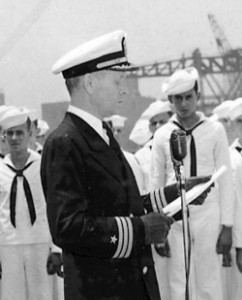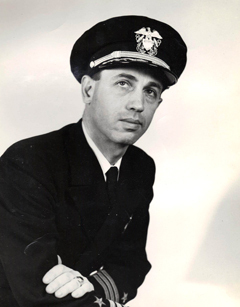Jeff Edwards's Blog, page 3
May 6, 2014
The Captain’s Hero
A few weeks ago, Commander Dan Dolan of the Naval War College had the opportunity to interview the commanding officer of the Navy’s newest combatant ship, USS Zumwalt. The lead vessel in a class of three next-generation destroyers, the Zumwalt isn’t just the most innovative ship in the U.S. Navy surface fleet. She is—quite literally—the most technologically advanced warship ever constructed.
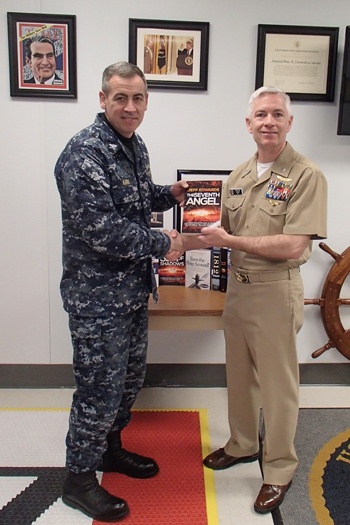
CDR James Kirk (left) and CDR Dan Dolan (right)
Published on the U.S. Naval Institute’s website, the interview transcript offers a rare glimpse into the mind of Commander James Kirk, who is preparing to assume command of warfighting capabilities which have never before been operationally deployed.
Prior to the interview, Commander Dolan was kind enough to invite me to submit a few questions of my own. As a student of naval warfare, I’m intensely curious about what impacts the Zumwalt class will have on the future of combat at sea, so several of my questions were centered on the integration of new technologies into current tactical doctrine. Some of my questions made it into the final version of the interview, but my favorite one didn’t end up making the editor’s cut.
I think it was a good question, and I believe that Commander Kirk’s response was worthy of publication. I obviously can’t influence what the Naval Institute chooses to publish, so I asked Commander Dolan’s permission to reprint it here.
My question was this…
Who was the most heroic person you ever served with?”
Here is Commander Kirk’s response…
I have served with a lot of folks that have done a lot of great things for our Navy. I look at it in the context of great leaders that I have served under, great peers that I worked alongside of and great sailors that I have worked with on the deck plates. When I reflect I can look up and see the great sea Captains that I have served with… Admirals Kemp and Hebner, both now retired, and Captains Villotti, Woodridge, Hoffman, Campbell and Wagner, each one of these officers were great leaders.
Then you look to your left and right and you see the Officers whom you served with, and you really felt like you were part of a band of brothers and sisters that could accomplish what needed to be done because you knew that together you could overcome any obstacle.
Then you look to those you worked alongside on the deck plates. I still think of GSE2 Frasier, when I watched the work he did, I was amazed at this young sailor who could trouble shoot, fix, and operate the plant under very difficult circumstances at times. Every day you are either getting better, or you are getting worse. You never stay the same, and it is only human effort that makes you continue to get better as a ship, or as a person. It is the folks that hook themselves up to the sled and pull, and keep pulling no matter what the difficulties, that I consider heroic.
I was honestly expecting Commander Kirk to provide one or two names as examples of the heroism he has encountered in the fleet. He certainly did that, but he went beyond, and gave us his personal litmus test for spotting heroes. They’re the ones who hook themselves up to the sled, and keep pulling no matter what the difficulties.
To this old Chief Petty Officer, that sounds like a pretty damned good definition. I hope Commander Kirk doesn’t mind too much that I’ll be using it myself in the future. I wish him, his crew, and his fine new ship the very best of fortune.
May God bless USS Zumwalt, and all who sail in her.
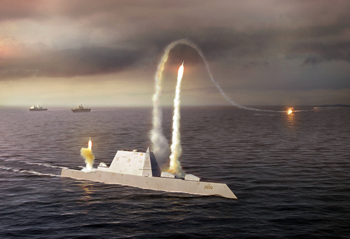
April 9, 2014
Remember His Name
You probably don’t recognize the name of Albert Kaplan, and frankly that’s a damned shame.
In 1943, Commander Kaplan was the executive officer aboard the USS Mayo, a U.S. Navy destroyer operating in the European Theater. On September 13th, during the Battle of Salerno, the USS Mayo and the light cruiser USS Brooklyn were called in to support the U.S. Fifth Army, which was pinned down on the beach at Salerno, Italy by superior fire. Up against three German divisions, more than 600 tanks, and numerous mobile guns, the U.S. invasion force was in danger of being pushed back into the sea.
Commander Albert D. Kaplan
With his commanding officer out of action due to illness, Commander Kaplan assumed command of USS Mayo, and took the destroyer within 500 yards of the beachhead. Assisted by an Army spotter plane, the ship engaged in direct firefights with German ground forces, hammering the enemy tanks and gun emplacements with 5” naval artillery rounds. The ship’s fire was so accurate that the spotter pilot recommended shifting the guns to rapid fire. Commander Kaplan concurred with the recommendation, and gave the order for rapid fire. Within a minute, USS Mayo’s guns were pumping out a shell every four seconds.
By the end of the engagement, 46 Nazi tiger tanks lay in flaming ruins, and the Mayo’s gun barrels were so overheated that the gray paint was blackened and the gun boots were scorched to something resembling charcoal. (Every gun barrel on the ship had to be replaced following the battle.)
Official Navy statistics show that the USS Mayo fired 60% of all 5” artillery at Salerno. The ship was awarded a Battle Star for her part in the engagement, and she is remembered by history as the U.S. Navy’s “tank buster.” Her commanding officer, Commander Frederic S. Habecker, received the Legion of Merit for his ship’s heroic actions during the combat.
Sadly, the ship’s executive officer—the man who actually led the fight—has been virtually overlooked by history. I’m certainly not trying to smear the name of Commander Habecker, who was a hero in his own right many times over. According to the men who served under him, Habecker was a gifted leader, a true warrior, and a fine naval officer. But in this one crucial battle, it was his second in command who held the reins of leadership and carried the ship and crew to victory.
The world has all but forgotten the name of Albert Kaplan. When I learned about his extraordinary story, I decided to name a U.S. Navy destroyer after him in one of my books. If you’ve ever read The Seventh Angel, you may recall the scenes where USS Albert D. Kaplan operates alongside USS Towers at the edge of the Siberian ice pack. It’s a small thing—naming a fictional warship after a real hero—but it’s my own humble way of keeping alive the legacy of a man who rose to the challenge when his country needed him.
If we do nothing else for our heroes, we should at least remember their names.
Remember His Name
You probably don’t recognize the name of Albert Kaplan, and frankly that’s a damned shame.
In 1943, Commander Kaplan was the executive officer aboard the USS Mayo, a U.S. Navy destroyer operating in the European Theater. On September 13th, during the Battle of Salerno, the USS Mayo and the light cruiser USS Brooklyn were called in to support the U.S. Fifth Army, which was pinned down on the beach at Salerno, Italy by superior fire. Up against three German divisions, more than 600 tanks, and numerous mobile guns, the U.S. invasion force was in danger of being pushed back into the sea.
Commander Albert D. Kaplan
With his commanding officer out of action due to illness, Commander Kaplan assumed command of USS Mayo, and took the destroyer within 500 yards of the beachhead. Assisted by an Army spotter plane, the ship engaged in direct firefights with German ground forces, hammering the enemy tanks and gun emplacements with 5” naval artillery rounds. The ship’s fire was so accurate that the spotter pilot recommended shifting the guns to rapid fire. Commander Kaplan concurred with the recommendation, and gave the order for rapid fire. Within a minute, USS Mayo’s guns were pumping out a shell every four seconds.
By the end of the engagement, 46 Nazi tiger tanks lay in flaming ruins, and the Mayo’s gun barrels were so overheated that the gray paint was blackened and the gun boots were scorched to something resembling charcoal. (Every gun barrel on the ship had to be replaced following the battle.)
Official Navy statistics show that the USS Mayo fired 60% of all 5” artillery at Salerno. The ship was awarded a Battle Star for her part in the engagement, and she is remembered by history as the U.S. Navy’s “tank buster.” Her commanding officer, Commander Frederic S. Habecker, received the Legion of Merit for his ship’s heroic actions during the combat.
Sadly, the ship’s executive officer—the man who actually led the fight—has been virtually overlooked by history. I’m certainly not trying to smear the name of Commander Habecker, who was a hero in his own right many times over. According to the men who served under him, Habecker was a gifted leader, a true warrior, and a fine naval officer. But in this one crucial battle, it was his second in command who held the reins of leadership and carried the ship and crew to victory.
The world has all but forgotten the name of Albert Kaplan. When I learned about his extraordinary story, I decided to name a U.S. Navy destroyer after him in one of my books. If you’ve ever read The Seventh Angel, you may recall the scenes where USS Albert D. Kaplan operates alongside USS Towers at the edge of the Siberian ice pack. It’s a small thing—naming a fictional warship after a real hero—but it’s my own humble way of keeping alive the legacy of a man who rose to the challenge when his country needed him.
If we do nothing else for our heroes, we should at least remember their names.
March 30, 2014
Holding Out For a Hero
As you’ve probably noticed, I’ve spent a lot of time lately talking about heroes. Not the larger-than-life icons who populate so many of our books and movies. The other kind. The kind who actually exist. The men and women who quietly and steadfastly answer the call of duty, stepping forward to do the tedious, difficult, and dangerous tasks that keep America strong.
In most cases we don’t know the names of these people, but we should. We reap the benefits of their work and their sacrifices every day, but we hardly ever learn who they are. We rarely have any idea of how much we owe them. These are the true heroes of our country, and their stories deserve to be heard.
With this in mind, we’ll be making a few changes to NavyThriller.com in the coming days. We’re adding a ‘Real Heroes’ section, to focus more closely on the kind of heroes who don’t usually attract the media spotlight, or capture the attention of the public.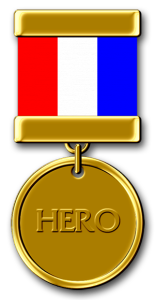
If you know someone who fits the bill, we invite you to let us know. Whether it’s your father, your daughter, your neighbor down the street, your sister, your son, or your departed (but not forgotten) grandfather. If you’ll share his or her story with us, we’ll do our very best to share it with the world.
We’re not necessarily looking for tales of heroism under wartime conditions, although we’re certainly interested in those as well. But it’s possible to serve an entire career in the military without ever being deployed to a combat zone. And many of the greatest hazards faced by our service members occur far from any field of battle.
Nor is heroism restricted to the military. To do any justice to the term, our search for heroes must extend to school teachers, police officers, bus drivers, firefighters, and anyone who rises to the challenge of making our lives safer, or doing their part to build a better world and a brighter future.
You probably already have somebody in mind, don’t you? Someone you know, who has made a difference in the world. Perhaps by a single instance of exquisite bravery, or perhaps through a lifetime of uncomplaining dedication to others.
Drop me an email at info@navythriller.com, and tell me a bit about the unrecognized hero in your life. This is not a homework assignment. You won’t be graded on spelling, grammar, or eloquence. Speak from your heart. If you need a little assistance with polishing the language, I happen to know a writer who can help.
So tell me… Who is your hero? It’s time for the stories to be told.
March 22, 2014
The Chief
To people outside the Navy, the words ‘the Chief’ have very little meaning. If anything, they tend to conjure up images of a Native American, decked out in the sort of feathered war bonnet made popular in old cowboy movies. But to those of us who have walked the steel decks, and kept the weather eye, the words take on an entirely different significance.
My first Chief (that’s Chief Petty Officer for you non-Navy types) was my boot camp Company Commander. His duties as CC pretty much overshadowed his actual rank, so I don’t really include him in the khaki pantheon. All of my memories of him involve military creases, inspections, and pumping out pushups in large multiples of ten. Oh, and I remember my CC’s tonsils. He spent an inordinate amount of time standing two inches away from my face, and shouting at the top of his lungs. In any case, I never thought of him as the Chief, and I certainly never dared to call him that. Anything less than Sir was likely to bring an invitation to something called a Mini-Motivational Tour, which was not nearly as entertaining as it sounds.
 I encountered my first real Chief aboard my first ship, a guided missile cruiser based out of Yokosuka, Japan in the early 1980s. Actually, he was a Senior Chief, but it’s the same club, and they play by the same rules. I reported aboard on a Saturday morning, and the Senior Chief was off the ship for the weekend. I didn’t get my first peek at him until the following Monday morning, by which time I’d heard two days of sea stories about him from the guys who had the weekend duty. Nearly every story seemed to end with the Senior Chief pulling some sort of minor miracle out of his garrison cap.
I encountered my first real Chief aboard my first ship, a guided missile cruiser based out of Yokosuka, Japan in the early 1980s. Actually, he was a Senior Chief, but it’s the same club, and they play by the same rules. I reported aboard on a Saturday morning, and the Senior Chief was off the ship for the weekend. I didn’t get my first peek at him until the following Monday morning, by which time I’d heard two days of sea stories about him from the guys who had the weekend duty. Nearly every story seemed to end with the Senior Chief pulling some sort of minor miracle out of his garrison cap.
After all the buildup, I was prepared for a giant of a man: eight feet tall, and covered with hair. At the very least, he should have been hovering in midair over the deck plates, or bathed in golden light. But the man didn’t look like anything special. His boondockers touched the deck just like mine did, and he appeared to make do with the same ordinary sunlight as the rest of us mortals. If anything, he was a little shorter than average, and seemed to be a bit inclined toward pudginess. I had to give him points for his uniform, though. His khakis were immaculate, crisply starched and sharply creased, but—other than that—he looked like any average guy off the street.
I began to feel stupid for believing the stories. I was the new kid on board, fresh out of basic training. Obviously, the duty personnel had decided to have a bit of fun with me. And, I decided, the much-lauded Senior Chief was just an average, ordinary guy. Boy was I ever wrong.
To say that Senior Chief was superhuman would certainly be an exaggeration. But I’d feel pretty comfortable using words like ‘amazing,’ or ‘phenomenal.’ His tactical skills were superb. He could rattle off the contents of every publication and manual in the safe. He could diagram complex search and attack plans from memory. He could tell you which plans worked, which ones didn’t, and why. He knew frequencies and operating modes for every tactical sonar in every navy. He could calculate torpedo gyro angles in his head, and he could practically smell a Soviet diesel submarine operating on batteries. Somehow, and I still don’t understand this, he managed to turn an aging cruiser with a thirty year old tube-powered sonar into one of the top Anti-Submarine Warfare ships in the Pacific. Other ships had quieter engineering plants, and better sonar systems. We had Senior Chief.
His expertise didn’t end with Anti-Submarine Warfare, either. He seemed to know a lot about everything. When he gave me my welcome aboard interview, I discovered that he knew quite a lot about me. I’d been on the ship less than three days, and he’d already been through my Personnel Record. He remembered my home town, my advancement goals, and my final grades from Sonar Technician A-School. He knew from my ASVAB scores (Armed Services Vocational Aptitude Battery) that I had an aptitude for mechanics and electronics, solid English skills, good spatial orientation abilities, and a weakness in Mathematics. I discovered that he had ordered several self-instruction books to help me improve my math skills, and he offered to help me find a tutor. This wasn’t to help me overcome a job-related deficiency. My skills were more than sufficient for Target Motion Analysis, Acoustic Range Predictions, and the other sorts of calculations common in Anti-Submarine Warfare. Senior Chief was preparing me for college, long before I knew I’d be moving in that direction. His interest in me wasn’t limited to the two or so years I’d be serving in his Division. He was already thinking about the rest of my life.
I learned a thousand other things from Senior Chief. I learned that a good leader rewards his personnel in public, but disciplines them in private. I learned how to think outside the box in a tactical situation, long before the phrase ‘outside the box’ had even been coined. I learned that fixing problems is more effective than fixing blame. I learned that people tend to live up to your expectations, or down to them, depending on where you set the bar. I learned about leadership, self-reliance, and personal integrity. I learned to value my own skills and abilities.
Over the twenty-something years that followed, I worked for quite a few Chiefs. With one notable (and ignoble) exception, every Chief Petty Officer I ever served under was a leader, a teacher, a mentor, and an expert in his field. Between them, they taught me tactics, acoustics, oceanography, electronics, discipline, sacrifice, confidence, and the value of preparation.
When it came time for me to put on my own khakis, as my sponsor pinned the anchors to my collar, I couldn’t help but measure myself against the standard set by Senior Chief, and by all the other Chiefs whose guidance helped to shape me as a person and as a Sailor. On the day that I made Chief, when the promotion ceremony was over and the crowd had gone home, I took out my little green notebook and started my list of things to accomplish. At the very top of the list, I wrote three words. I continued writing those three words in every notebook I carried until the day I retired. Be the Chief. That was the first action item on my list, and my first responsibility.
I hope that I lived up to it.
(Originally published on Military.com 01/26/05)
March 6, 2014
Rogue Avenger
If a single U.S. Trident missile sub went rogue, it would instantly become the fifth most powerful nuclear aggressor on planet Earth. According to some estimates, that lone submarine would possess more firepower than the combined nuclear arsenals of India, Pakistan, and North Korea. More than enough warheads to start World War III. Maybe even enough to end it.
 Of course the Navy has extraordinary safeguards in place to prevent this kind of nightmare scenario from ever occurring. Mechanical and electronic lock-outs, security protocols, safety procedures, psychological screenings, and all manner of protections that go well beyond both my knowledge and my imagination. But no defense is ever perfect, and all of our protective measures have one thing in common… They depend on the loyalty of human beings.
Of course the Navy has extraordinary safeguards in place to prevent this kind of nightmare scenario from ever occurring. Mechanical and electronic lock-outs, security protocols, safety procedures, psychological screenings, and all manner of protections that go well beyond both my knowledge and my imagination. But no defense is ever perfect, and all of our protective measures have one thing in common… They depend on the loyalty of human beings.
Which raises an extremely unsettling question… What happens when the humans fail? (Or worse, what happens when they deliberately sabotage the system they’re supposed to be protecting?) That’s a damned scary thought. It also happens to be one hell of a good idea for a military techno-thriller. I’d love to write that book. Unfortunately, John R. Monteith already beat me to it with his white-hot submarine warfare novel, Rogue Avenger.
Just in case you haven’t yet had the pleasure of reading this book, allow me to quote from the jacket text…
THEY STOLE HIS FUTURE. HE STOLE THEIR SUBMARINE.
The accident changed everything… One moment, Lieutenant Jake Slate was going about his duties aboard the ballistic missile submarine, USS Colorado. The next second, he was sprawled on the deck plates in a spreading puddle of blood and hydraulic fluid. But it wasn’t the injury that ruined his life and doomed his military career. It was the rescue effort.
Now he’s being thrown to the wolves to cover up the misdeeds of a superior officer, and Jake doesn’t care for the role of sacrificial lamb.
Blinded by rage and unsure of his future, he finds himself at the center of a treacherous plot to hijack the Colorado and sell her nuclear warheads to a foreign power. Jake no longer knows who he can trust. He doesn’t know what the future holds. He really only knows one thing. He will have his revenge.
If that doesn’t give your pulse rate a little boost, you should consult your doctor, because you may be dead.
In addition to being a talented writer, John Monteith is a former U.S. Navy officer who served aboard a Trident sub. His knowledge and experience come through clearly in his writing. He’s done his time on nuclear deterrent patrols. He’s had plenty of time to think about what could go wrong, and he does an excellent job weaving some of his darker speculations into page-turning adventure fiction.
I first met John a few years ago, at a conference for the Military Writers’ Society of America. I was there to shake hands and meet other authors. He was there to accept an award for this novel. I picked up a copy from the display tables, leafed through a couple of pages, and suddenly I was hooked.
When I decided to start the Stealth Books imprint, John was the first author I invited to join. My goal from the beginning has been to attract smart authors who write smart books for smart readers. John certainly fits the bill, and so does this novel.
I can sum up my opinion of Rogue Avenger in seven words: I wish I had written this book.
Rogue Avenger is now available on Kindle and in paperback from Amazon.com, along with John’s follow-on novels, Rogue Betrayer, Rogue Crusader, and Rogue Defender.
Click here to visit John’s website, SubThriller.com.
February 27, 2014
Six Frigates – Book Review
Six Frigates: The Epic History of the Founding of the U.S. Navy
As a career Sailor, a writer of naval fiction, and a bit of an amateur nautical historian, I like to flatter myself that I’m fairly well versed in the history of the United States Navy. After reading Ian W. Toll’s handling of our navy’s formative years, I’m quite content to admit my own vanity and ignorance. Six Frigates, if I may abuse a metaphor, blew me out of the water.
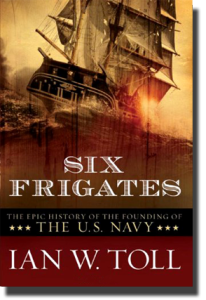 I bought the book expecting to read descriptions of naval engagements in the age of sail, and Ian Toll certainly delivers in that area. He makes you feel the thunder of hurtling grape shot, and smell the hot iron and smoke of combat at sea. He also goes a step further, and pulls back the curtain on battles of an entirely different sort; the kind that rage across the debating floors of government.
I bought the book expecting to read descriptions of naval engagements in the age of sail, and Ian Toll certainly delivers in that area. He makes you feel the thunder of hurtling grape shot, and smell the hot iron and smoke of combat at sea. He also goes a step further, and pulls back the curtain on battles of an entirely different sort; the kind that rage across the debating floors of government.
Most books I’ve read about this period tend to gloss over the authorization and building of these famous first ships, skipping from the Naval Act of 1794 (which approved their construction), to their launchings beginning in 1797, to the USS Constellation’s historic defeat and capture of the French frigate Insurgente in February of 1799. Until Six Frigates, I happily agreed with the tendency to jump forward to the action. The Barbary pirates… The USS Constitution’s victorious engagements against HMS Guerriere, HMS Java, HMS Cyane, and HMS Levant. That often-referenced moment during the War of 1812 when some unknown seaman shouted, “Hurrah, her sides are made of iron!”
But Mr. Toll’s extraordinary history also captures the skirmishes that erupted before the keels were laid. It turns out that the politics of military procurement were every bit as nasty in the eighteenth-century as they are in the twenty-first. The decision to construct the U.S. Navy’s first purpose-built warships was a source of bitter contention. On the one side, the Federalist Party—formed by Alexander Hamilton—saw a strong naval force as an indispensable resource for a growing nation. On the opposite side of the aisle, Thomas Jefferson and the newly-emerging Republican Party were fiercely against building a navy. The country was still staggering under the debts of the Revolutionary War, and the Republicans argued that the cost of maintaining a navy would cripple the fledgling national economy.
Toll reveals that the challenges kept on coming, even after the appropriations were 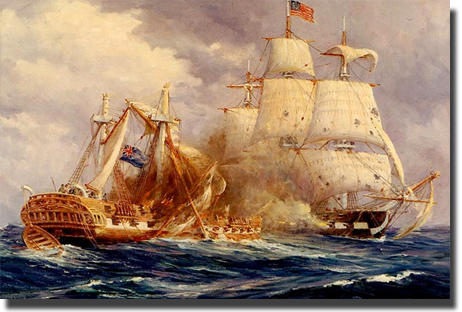 approved. The ship designer, Joshua Humphreys, decided that the major timbers and framing for the frigates must be cut from southern live oak, which was known for its extreme strength and durability. The right kind of trees could only be found in quantity along the Georgia coast, in areas that were little more than swamp. So the War Department ordered a ninety-man logging crew into the swamp to retrieve the needed timber. Within a week, nearly all of the workers were struck down by malaria. A visitor compared the stricken logging camp to an army field hospital after a hideous battle. Construction on the ships had not even started yet, and already the casualties were beginning to mount.
approved. The ship designer, Joshua Humphreys, decided that the major timbers and framing for the frigates must be cut from southern live oak, which was known for its extreme strength and durability. The right kind of trees could only be found in quantity along the Georgia coast, in areas that were little more than swamp. So the War Department ordered a ninety-man logging crew into the swamp to retrieve the needed timber. Within a week, nearly all of the workers were struck down by malaria. A visitor compared the stricken logging camp to an army field hospital after a hideous battle. Construction on the ships had not even started yet, and already the casualties were beginning to mount.
I could toss out more examples, but I won’t. My point is simply this… Ian W. Toll touches on many details that might have been overlooked by other authors. As a consequence, he brings an entirely new level of nuance to America’s evolution as a naval power. Six Frigates is easily one of the most informative and enjoyable books I’ve ever read about this chapter of our navy’s history.
February 20, 2014
A Stupendously Badass Character Named Dirk Pitt
I’ve been a HUGE fan of Clive Cussler novels since I first laid eyes on a paperback copy of Vixen 03 in a drugstore book rack, way back in the late 1970s. The green-shaded cover illustration sported the ghostly form of a Boeing C-97 Stratofreighter lying broken on the bottom of the sea, a column of air bubbles still rising from the crashed aircraft’s fuselage. I snatched the book out of the rack, flipped it over, and read the teaser text on the back jacket.
An Air Force transport plane with a lethal Top Secret cargo vanishes without a trace. A retired battleship pressed back into service for a final mission that could bring the United States to its knees. Politics… Intrigue… Adventure… My kind of stuff? Oh yeah. Oh hell yeah…
When the clerk rang up the sale, I wouldn’t even let him put my book in a bag. I forked over my cash and stuck the sales receipt between the pages as a makeshift bookmark. I walked out of that drugstore with the treasured paperback tucked neatly under my arm, secure in the knowledge that I had found something special.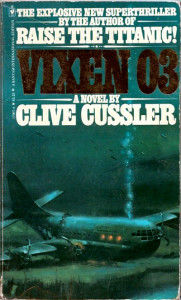
I was not disappointed. The writing had my pulse pounding from the very first paragraph. The plot completely blew me away. I literally stayed up all night to read it. By the time I reluctantly turned the last page at about four in the morning, I knew I would be a Cussler fan for the rest of my life. Who needed James Bond or Luke Skywalker? I had discovered a stupendously badass character named Dirk Pitt.
When I found out that there were three more Dirk Pitt novels in print, I nearly had a seizure. This was in the dark days before the internet, and the words Amazon-dot-com had yet to be spoken on planet Earth. I spent endless weeks stalking the shelves of used book stores until I finally located copies of The Mediterranean Caper, Iceberg, and Raise the Titanic.
I blew through all three of my new treasures in a matter of days, and then began my long wait. I knew that Mr. Cussler was out there somewhere, pecking away at the keys of his typewriter and turning out more pages of adrenaline-fueled reading fun. If I watched long enough, sooner or later, another Pitt adventure was bound to surface.
And so it did… In another year or two, Night Probe came along. And then Deep Six, and Cyclops. The stories kept getting better, and old Dirk just kept right on saving the world from the kinds of villains that Bond only dreamed of.
The years turned into decades, and the Dirk Pitt stories continued to appear at fairly regular intervals. Treasure. Dragon. Sahara. Inca Gold.
I loved them all, but I was especially fond of Arctic Drift. It hit the shelves in 2008, the year that one of my own novels won the Clive Cussler Grandmaster Award. Clive himself presented me with the award check. His son and coauthor, Dirk (the namesake of my very favorite badass) handed me the trophy.
That was the absolute highpoint of my life as a Cussler fanatic. I had met the authors of my favorite books. Shaken their hands. Received their generous accolades, and the kind words of advice that they offered to me as a fellow author. I had reached the zenith. There was nowhere else to go. Nowhere higher to climb.
Or so I thought…
Then, a year or so ago, I received an early morning text message from retired Rear Admiral John Waickwicz. He wanted to know if I’d read Poseidon’s Arrow, the latest Dirk Pitt Novel. It was a Sunday, and I was having one of my rare sleep-in mornings. Rubbing my eyes until they were clear enough to make out the screen of my phone, I replied that I had not yet read Poseidon’s Arrow, but it was at the top of my to-be-read stack.
The admiral’s reply was short, but emphatic. “Read Chapter 26!”
I texted back two words. “Will do.”
I fired up my Kindle (no pun intended), settled into a comfy position on my couch, and started to read. I was tempted to skip ahead to Chapter 26, to find out what the admiral was excited about. But that’s just not the proper way to read a Dirk Pitt story. You have to savor it. No… Actually, you have to devour it. But you don’t jump ahead to the good parts, because they’re ALL good parts.
So I started at the beginning, flipping electronic pages as  fast as my sleep-addled brain could gobble up the words. It took no time at all for the story to suck me in. Dirk was in rare form once again—jousting with bad guys, flirting with disaster, and taking in the world through those depthless green eyes that make certain women a bit weak in the knees.
fast as my sleep-addled brain could gobble up the words. It took no time at all for the story to suck me in. Dirk was in rare form once again—jousting with bad guys, flirting with disaster, and taking in the world through those depthless green eyes that make certain women a bit weak in the knees.
I was so wrapped up in the action and intrigue that I completely forgot about the admiral’s text message. I didn’t need a reason to read this book. This was Dirk fucking Pitt! Reason enough.
Then I came to Chapter 26, and my eyes nearly bugged out of my head. Allow me to quote from the opening paragraph…
“The Gulfstream’s wheels touched down with a thump, jarring Ann awake. The excitement of the past few days had finally caught up with her, and she had slept since the plane left the ground in Idaho. She yawned and glanced across the aisle at Pitt, who sat engrossed reading a Jeff Edwards novel.”
WHAT? What was that?
Had my brain processed the words correctly? Dirk Pitt was engrossed in reading a Jeff Edwards novel? The stupendous badass of stupendous badasses was reading a Jeff Edwards novel?
I read the paragraph again. The words were still there, shining from the screen of my Kindle Fire like flaming beacons of badassery.
I’ve have a while now to get over the shock, but the joy and amazement have never faded. Dirk Pitt reads my books. How cool is that?
February 2, 2014
Does the Hero’s Journey Make Us Blind to Real Heroes?
Trivia question of the day… What do Finding Nemo, The Matrix, Watership Down, The Hunger Games, Star Wars, The Lion King, and Harry Potter all have in common? If you’re a writer of fiction, you probably already know the answer… Every one of these films and novels follows a story structure known as the Hero’s Journey.
Also commonly referred to as the monomyth, the Hero’s Journey was first documented by mythologist Joseph Campbell in his 1949 nonfiction book, The Hero with a Thousand Faces. Campbell’s thesis was that nearly all heroic myths—regardless of time period or culture—tend to follow a specific series of steps in a (largely) predictable order. Beginning in the ‘Ordinary World,’ the hero receives a ‘Call to Adventure,’ which he/she initially rejects. Then comes ‘Meeting the Mentor’ (also known as ‘Supernatural Aid’), followed by ‘Crossing the Threshold.’ After that, the proverbial game is afoot.
 I’m not going to map out the entire cycle here. There are endless books, videos, diagrams, articles, essays, and blogs on the subject, many of which are available for free right here on the good old interwebs.
I’m not going to map out the entire cycle here. There are endless books, videos, diagrams, articles, essays, and blogs on the subject, many of which are available for free right here on the good old interwebs.
I’m more interested in the impact of Campbell’s famous myth structure on our perception of heroism. Specifically, does the continual reinforcement of the fictional hero pattern actually interfere with our ability to recognize real-life heroes?
Before we try to answer that, let’s look at how the monomyth structure made the leap from an obscure scholarly work to the mainstream of public consciousness.
In the mid-1980s, Chris Vogler, a story consultant for Walt Disney Pictures, wrote a seven-page memo titled A Practical Guide to the Hero with a Thousand Faces. The memo—which has since become almost a holy relic in the film industry—outlined the major points of the monomyth, and provided a map for folding them into the well-known three act structure used in nearly all commercial movies.
It’s worth noting that filmmakers were studying Campbell’s writings long before Chris Vogler came along. In fact, George Lucas worked directly with Joseph Campbell in the 1970s, during the making of the first Star Wars film, to ensure that the phases of the Hero’s Journey were being properly captured. This was six or eight years before Vogler wrote his famous seven-page memo, and Lucas wasn’t the first writer/director to be influenced by the monomyth.
Nevertheless, it was Vogler’s now-famous memo that ultimately kicked the process into overdrive. This was in the age of the fax machine, and suddenly Hollywood’s telephone wires were buzzing with faxed copies of the memo. Every studio executive, director, producer, screen writer, and talent agent was scrambling to lay hands on the document.
To say that the effect on filmmaking was transformational would almost be an understatement. If you don’t believe me, look at nearly any successful movie made in Hollywood since 1985. Let’s take The Matrix as an example. Call to Adventure? Check! Refusal of the Call? Check! Meeting the Mentor? Check! Crossing the Threshold? Check!
Beginning to see the pattern? It’s there, in movie after movie, and in book after book. Hell, I went there myself in Dome City Blues, without even meaning to. I’d seen the monomyth depicted so many times that it slipped into my subconscious. With no intent on my part, it influenced the shape of David Stalin’s heroic journey.
Does this make Dome City Blues a flawed work? I don’t think so. (Or at least I hope not.) I’m not one of the growing body of writers who are turning against Campbell and his theories. I don’t happen to agree that following the Hero’s Journey will automatically produce cookie-cutter stories. As Campbell pointed out, the tales of Gilgamesh, Beowulf, and Moses all map fairly well to the monomyth cycle. When you compare these to Finding Nemo, The Matrix, and Watership Down, it’s clearly possible to create wildly different stories within the framework of the monomyth. A writer can spend an entire career exploring the boundaries of the Hero’s Journey without ever producing two works that are recognizably similar.
So why have I been deliberately turning away from this time-honored structure in my military novels? I’m glad you asked…
For all of its usefulness as a storytelling device, I’m increasingly concerned about the impact it appears to be having in the real world. As we see the pattern repeated again and again, it becomes more and more reinforced in our subconscious minds.
This is how a hero acts.
This is what a hero does first.
This is what a hero does next.
This is how a hero defeats the enemy.
This is how a hero accomplishes the quest.
Somewhere in all those hundreds (and thousands) of fictional repetitions, we start to lose our ability to recognize real heroes. I had the privilege of serving in the company of real heroes, and I can tell you that their journeys bear very little resemblance to the mythic hero structure.
When the call to adventure comes, real heroes don’t even think about refusing. They pack up their gear, saddle up, and go where they’re needed. Real heroes are not chosen by prophesy. They step forward, and consciously choose to make a difference in the world. Real heroes rarely have great and mythic adventures. Instead, they maintain their equipment, continually train themselves and their coworkers, stand endless watches, and drill, drill, drill. Much of their lives amount to drudgery that wouldn’t play very well in a Hollywood movie. When the moment of conflict comes, real heroes don’t leap forward like avenging angels, brandishing swords, or lances, or magic wands. They concentrate on their own little piece of the struggle, carrying out their duties under enemy fire, or in dirty and life-threatening conditions, perfectly aware that their efforts will almost certainly go unsung.
And when they return to the ‘Ordinary World,’ they will not be heralded as figures of legend, nor will they be transformed into what Campbell called the ‘Master of Two Worlds.’ They will begin preparing for their next deployment, and waiting for the next ‘Call to Adventure.’
I hope my readers won’t take this as an indictment of the monomyth construct. That’s absolutely not my intent. I’ve enjoyed many movies and books that conform to the hero cycle. In my opinion, it’s a hell of a good way to tell a story.
I just want to remind the world that real heroes aren’t imbued with the mythic aura of Gilgamesh, or Beowulf, or even Luke Skywalker. Real heroes are more likely to resemble the man or woman standing next to you in the supermarket checkout line. If you’re looking through the lens of the Campbell’s monomyth, you’re never going to see them at all.
January 31, 2014
A Sword Into Darkness
In addition to my well-known love of military thrillers, I’ve been a huge fan of science fiction since I was old enough to register for my first library card. (If you don’t know what a library card is, ask someone older than you. For my money, library cards are still pretty damned cool.) But I digress…
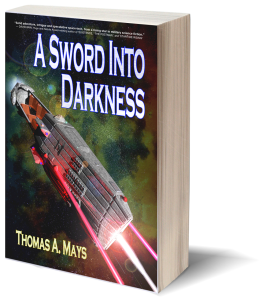 Military thrillers and sci-fi. Like peanut butter and chocolate, I’d be hard put to decide which one I love more. Luckily, there are a handful of writers out there who know how to combine these two wonderfully explosive ingredients into a single delectable confection that goes to the sweet spot in my brain waaaaaaay faster than a Reese’s Peanut Butter Cup.
Military thrillers and sci-fi. Like peanut butter and chocolate, I’d be hard put to decide which one I love more. Luckily, there are a handful of writers out there who know how to combine these two wonderfully explosive ingredients into a single delectable confection that goes to the sweet spot in my brain waaaaaaay faster than a Reese’s Peanut Butter Cup.
My long-time friend and old shipmate, Tom Mays, just happens to be such a writer. His first novel, A Sword Into Darkness, just went on sale and—trust me—it’s everything that a military sci-fi story should be, and then some.
I practically had to beg, borrow, and steal to lure Tom into the Stealth Books lineup. I’m happy that he eventually gave into the dark side of the force, because Sword is the best space combat novel I’ve ever read, bar none. If you’re even half as big a fan of military science fiction as I am, this book is going to knock your socks into the freaking asteroid belt.
A Sword Into Darkness is now available on Kindle and in paperback from Amazon.com.
Click here to visit Tom’s blog, The Improbable Author.

